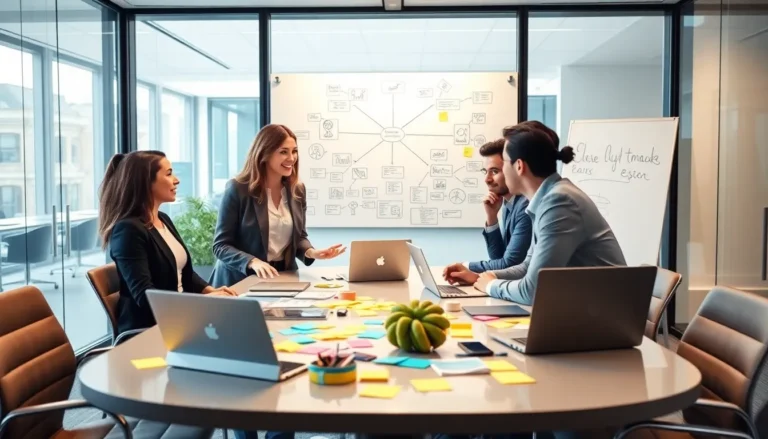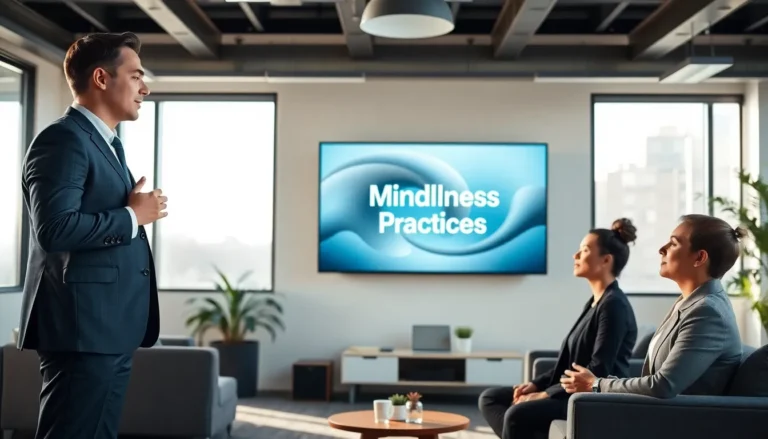Table of Contents
ToggleImagine facing a mountain of daunting problems, each seeming more unsolvable than the last. Now, what if a sprinkle of creativity could transform those challenges into exciting opportunities? Creative thinking isn’t just a flashy concept, it’s a game changer in the world of problem solving. Whether you’re a budding entrepreneur or a seasoned manager, harnessing the power of creative thought can propel you forward. So, buckle up and prepare to jump into the fascinating realm of creative thinking and problem solving, where imagination meets practicality and innovation is born.
Understanding Creative Thinking

Creative thinking goes beyond just artistic talent or the ability to doodle on a napkin. It involves generating new ideas, exploring multiple perspectives, and questioning the norm. At its core, creative thinking is about finding unique solutions to problems, often by looking at them from unexpected angles. Think of it as trying to solve a Rubik’s cube, not just following the algorithm but experimenting with different moves until the pieces fall into place.
In educational and professional settings, creative thinking is nurtured through curiosity, open-mindedness, and the willingness to embrace failure as a stepping stone. To truly understand it, one must appreciate its role as a driving force behind innovation, be it in technology, art, or everyday problem solving.
Creative thinkers are often excellent at lateral thinking, which involves jumping between different ideas rather than following a straight line of thought. This flexibility allows them to adapt swiftly to new information and challenges, making them invaluable in any team.
The Importance Of Creative Thinking In Problem Solving
Why is creative thinking crucial in problem solving? For starters, traditional methods of resolution can sometimes feel like fitting a square peg into a round hole. When one solution doesn’t work, creative thinking allows individuals to explore alternative routes that might not be immediately obvious.
Many people rely on logic and rationality, the go-to tools for problem solving: but, creativity brings flavor and depth to the process. It encourages fresh perspectives and innovative solutions, which are essential in today’s fast-paced and ever-evolving landscapes.
Besides, organizations that foster creative thinking tend to outperform their competitors. They are more resilient, able to pivot swiftly when facing obstacles. Companies like Google and Apple thrive because they empower their employees to think outside the box, exploring the unusual or whimsical instead of adhering strictly to conventional guidelines. In essence, creative thinking transforms challenges into opportunities, fostering innovation and igniting growth.
Techniques To Enhance Creative Thinking
Enhancing creative thinking doesn’t require a magic wand: it takes practice and intention. Here are some techniques that can help individuals tap into their creative potential:
1. Brainstorming
Brainstorming is a classic method aimed at generating a plethora of ideas without judgment. The focus here is on quantity over quality: letting ideas flow freely can lead to unexpected breakthroughs.
2. Mind Mapping
Mind mapping visually organizes thoughts and concepts. By mapping out ideas and seeing connections, individuals can spark new insights and pathways.
3. Role Playing
This technique involves stepping into someone else’s shoes, literally or figuratively. It provides fresh perspectives on a problem by exploring how a different individual or persona might handle the task at hand.
4. Embracing Constraints
Sometimes, limitations can fuel creativity. By introducing specific challenges or restrictions, individuals can think more innovatively and find unique solutions that they might have overlooked otherwise.
Incorporating these techniques into daily routines can stimulate creativity, making it easier to approach problems with an open mind.
Problem Solving Strategies
Creative problem-solving demands a strategic approach, blending analytical and imaginative techniques. Here are a few effective strategies:
1. Define the Problem Clearly
Understanding what is at stake is crucial. A well-defined problem allows for focused solutions. Ask questions to uncover the root cause, not just the symptoms.
2. Decompose the Problem
Breaking problems into smaller, more manageable parts can alleviate overwhelm and help targeted thinking. Tackling each component individually can lead to comprehensive solutions.
3. Evaluate Solutions Holistically
When weighing potential solutions, consider their broader implications. Creative solutions should not only resolve the immediate issue but also align with overarching goals and values.
4. Carry out and Iterate
Once a solution is chosen, it’s vital to carry out it effectively. But, this is just the beginning: gather feedback and be open to refining the strategy for maximum effectiveness.
This combination of clarity, division, evaluation, and adaptability can make problem-solving much more effective.
The Role Of Collaboration In Creative Problem Solving
Collaboration can amplify creative thinking and problem-solving. When individuals come together, diverse perspectives and skills merge, leading to richer ideas and solutions. Teamwork encourages the out-of-the-box thinking that often leads to innovative outcomes.
Ideas can flourish in a collaborative environment where members feel free to share and build upon each other’s thoughts. Techniques such as design thinking promote this spirit of collaboration, emphasizing empathy, experimentation, and inclusivity. Workshops or group brainstorming sessions can serve as catalysts, sparking inspiration through collective energy.
Also, technology facilitates collaboration in our digital age. Virtual whiteboards and communication tools allow teams to connect geographically and brainstorm effectively. Overcoming geographical limitations enables a blend of ideas and approaches that strengthen creative problem-solving capabilities.
Case Studies: Successful Creative Problem Solving
Examining case studies of successful creative problem-solving can shed light on how theories come alive in practice.
1. IDEO’s Design Process
IDEO, a design and consulting firm, revolutionized the way products are created by employing a human-centered, design-based approach. Their innovative method allowed them to develop the first Apple computer mouse through extensive prototyping and user research. This case showcases how creativity applied strategically leads to breakthroughs.
2. Starbucks’ Customer Experience
Starbucks revamped its customer experience by integrating digital technology and community engagement. By listening to customer feedback and embedding creativity in operational design, they transformed the coffee shop experience, showcasing how adaptive solutions lead to increased customer loyalty.
3. Airbnb’s Problem-Solving Culture
Airbnb faced significant hurdles when expanding its global reach. By fostering a culture that encouraged team members to experiment and embrace creative risks, they were able to develop effective solutions that not only resolved existing issues but also spurred the company’s growth.
These examples illustrate how creative thinking applied in real-world contexts can yield remarkable results, underscoring its importance.




